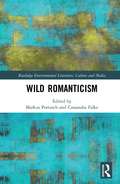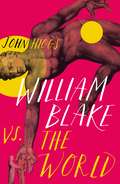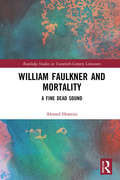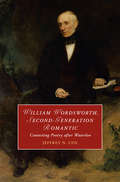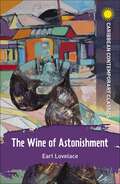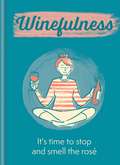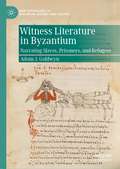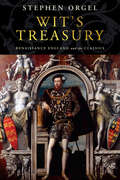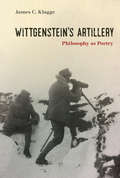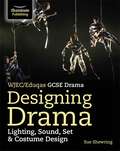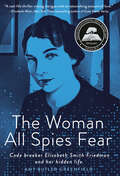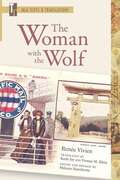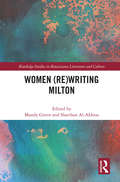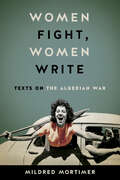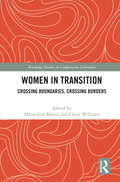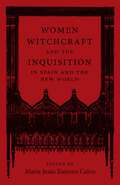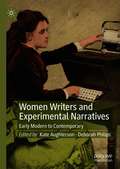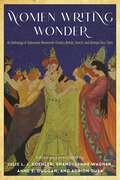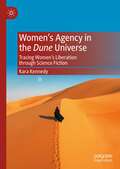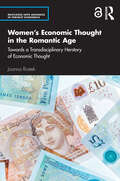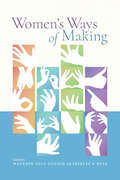- Table View
- List View
Wild Romanticism (Routledge Environmental Literature, Culture and Media)
by Markus Poetzsch Cassandra FalkeWild Romanticism consolidates contemporary thinking about conceptions of the wild in British and European Romanticism, clarifying the emergence of wilderness as a cultural, symbolic, and ecological idea. This volume brings together the work of twelve scholars, who examine representations of wildness in canonical texts such as Frankenstein, Northanger Abbey, "Kubla Khan," "Expostulation and Reply," and Childe Harold´s Pilgrimage, as well as lesser-known works by Radcliffe, Clare, Hölderlin, P.B. Shelley, and Hogg. Celebrating the wild provided Romantic-period authors with a way of thinking about nature that resists instrumentalization and anthropocentricism, but writing about wilderness also engaged them in debates about the sublime and picturesque as aesthetic categories, about gender and the cultivation of independence as natural, and about the ability of natural forces to resist categorical or literal enclosure. This book will be of great interest to students and scholars of Romanticism, environmental literature, environmental history, and the environmental humanities more broadly.
Will the Wolf: Targeting the w Sound (Speech Bubbles 2)
by Melissa PalmerWill sits and watches the world go by, feeling all alone. Will he be alone forever? This picture book targets the /w/ sound and is part of Speech Bubbles 2, a series of picture books that target specific speech sounds within the story. The series can be used for children receiving speech therapy, for children who have a speech sound delay/disorder, or simply as an activity for children’s speech sound development and/or phonological awareness. They are ideal for use by parents, teachers or caregivers. Bright pictures and a fun story create an engaging activity perfect for sound awareness. Picture books are sold individually, or in a pack. There are currently two packs available – Speech Bubbles 1 and Speech Bubbles 2. Please see further titles in the series for stories targeting other speech sounds.
William Blake vs the World
by John Higgs'A glittering stream of revelatory light . . . Fascinating' THE TIMES'Rich, complex and original' TOM HOLLAND'One of the best books on Blake I have ever read' DAVID KEENAN'Absolutely wonderful!' TERRY GILLIAM'An alchemical dream of a book' SALENA GODDEN'Tells us a great deal about all human imagination' ROBIN INCE***Poet, artist, visionary and author of the unofficial English national anthem 'Jerusalem', William Blake is an archetypal misunderstood genius. His life passed without recognition and he worked without reward, mocked, dismissed and misinterpreted. Yet from his ignoble end in a pauper's grave, Blake now occupies a unique position as an artist who unites and attracts people from all corners of society, and a rare inclusive symbol of English identity. Blake famously experienced visions, and it is these that shaped his attitude to politics, sex, religion, society and art. Thanks to the work of neuroscientists and psychologists, we are now in a better position to understand what was happening inside that remarkable mind, and gain a deeper appreciation of his brilliance. His timeless work, we will find, has never been more relevant.In William Blake vs the World we return to a world of riots, revolutions and radicals, discuss movements from the Levellers of the sixteenth century to the psychedelic counterculture of the 1960s, and explore the latest discoveries in neurobiology, quantum physics and comparative religion. Taking the reader on wild detours into unfamiliar territory, John Higgs places the bewildering eccentricities of a most singular artist into context. And although the journey begins with us trying to understand him, we will ultimately discover that it is Blake who helps us to understand ourselves.
William Faulkner and Mortality: A Fine Dead Sound (Routledge Studies in Twentieth-Century Literature)
by Ahmed HoneiniWilliam Faulkner and Mortality is the first full-length study of mortality in William Faulkner’s fiction. The book challenges earlier, influential scholarly considerations of death in Faulkner’s work that claimed that writing was his authorial method of ‘saying No to death’. Through close-readings of six key works – The Sound and the Fury, As I Lay Dying, "A Rose for Emily", Light in August, Absalom, Absalom!, and Go Down, Moses – this book examines how Faulkner’s characters confront various experiences of human mortality, including grief, bereavement, mourning, and violence. The trauma and ambivalence caused by these experiences ultimately compel these characters to ‘say Yes to death’. The book makes a clear distinction between Faulkner’s quest for literary immortality through writing and the desire for death exhibited by the principal characters in the works analysed. William Faulkner and Mortality: A Fine Dead Sound offers a new paradigm for reading Faulkner’s oeuvre, and adds an alternative voice to a debate within Faulkner scholarship long thought to have ended.
William Wordsworth, Second-Generation Romantic: Contesting Poetry after Waterloo (Cambridge Studies in Romanticism)
by Jeffrey CoxWilliam Wordsworth, Second-Generation Romantic provides a truly comprehensive reading of 'late' Wordsworth and the full arc of his career from (1814–1840) revealing that his major poems after Waterloo contest poetic and political issues with his younger contemporaries: Keats, Shelley and Byron. Refuting conventional models of influence, where Wordsworth 'fathers' the younger poets, Cox demonstrates how Wordsworth's later writing evolved in response to 'second generation' romanticism. After exploring the ways in which his younger contemporaries rewrote his 'Excursion', this volume examines how Wordsworth's 'Thanksgiving Ode' enters into a complex conversation with Leigh Hunt and Byron; how the delayed publication of 'Peter Bell' could be read as a reaction to the Byronic hero; how the older poet's River Duddon sonnets respond to Shelley's 'Mont Blanc'; and how his later volumes, particularly 'Memorials of a Tour in Italy, 1837', engage in a complicated erasure of poets who both followed and predeceased him.
The Wine of Astonishment
by Earl LovelaceEarl Lovelace writes about the survival of a small community of Spiritual Baptists with a lyricism and understanding of dialogue which has established an international reputation.'If we clap we hands and catch the Spirit, the police could arrest us. One day we was Baptist, the next day we is criminals.'The Wine of Astonishment is a poignant and devastating tale of the discrimination the Black community of Bonasse faced during the first half of the 20th century. Told from the perspective of a religious wife, Eva retells the torment and tribulations her family and friends endure at the hands of abusive police and corrupt government officials. Hurtling towards its tragic climax, Bolo's transformation embodies the tragedy manifested when a people are pushed too far.
The Wine of Astonishment (Caribbean Modern Classics)
by Earl LovelaceEarl Lovelace writes about the survival of a small community of Spiritual Baptists with a lyricism and understanding of dialogue which has established an international reputation.'If we clap we hands and catch the Spirit, the police could arrest us. One day we was Baptist, the next day we is criminals.' The Wine of Astonishment is a poignant and devastating tale of the discrimination the Black community of Bonasse faced during the first half of the 20th century. Told from the perspective of a religious wife, Eva retells the torment and tribulations her family and friends endure at the hands of abusive police and corrupt government officials. Hurtling towards its tragic climax, Bolo's transformation embodies the tragedy manifested when a people are pushed too far.
Winefulness: It's time to stop and smell the rosé
by Amelia LovedayWinefulness is the new mindfulness.Cancel the hot yoga and pick up a cool Pinot Grigio - sometimes all you need is a nice glass of wine. Through the good times and the bad, it's always there to pick you up and it's always got your back. So enjoy this collection of wine wisdom for the soul, and learn to view the world through rosé-tinted glasses.As the old saying goes, where there's a wine there's a way.Includes inspiration such as:- It isn't wise to keep things bottled up - No Champagne, no gain- Life is a Cabernet, after all- Every cloud has a Syrah lining- Do things for the right Rieslings
Winefulness: It's time to stop and smell the rosé
by Amelia LovedayWinefulness is the new mindfulness.Cancel the hot yoga and pick up a cool Pinot Grigio - sometimes all you need is a nice glass of wine. Through the good times and the bad, it's always there to pick you up and it's always got your back. So enjoy this collection of wine wisdom for the soul, and learn to view the world through rosé-tinted glasses.As the old saying goes, where there's a wine there's a way.Includes inspiration such as:- It isn't wise to keep things bottled up - No Champagne, no gain- Life is a Cabernet, after all- Every cloud has a Syrah lining- Do things for the right Rieslings
Witness Literature in Byzantium: Narrating Slaves, Prisoners, and Refugees (New Approaches to Byzantine History and Culture)
by Adam J. GoldwynThis book analyzes Byzantine examples of witness literature, a genre that focuses on eyewitness accounts written by slaves, prisoners, refugees, and other victims of historical atrocity. It focuses on such episodes in three nonfictional texts – John Kaminiates’ Capture of Thessaloniki (904), Eustathios of Thessaloniki’s Capture of Thessaloniki (1186), and Niketas Choniates’ History (ca. 1204–17) – and the three extant twelfth-century Komnenian novels to consider how the authors’ positions as both eyewitness and victim require an interpretive method that distinguishes witness literature from other kinds of writing about the past. Drawing on theoretical developments in the fields of Holocaust and Genocide Studies (such as Giorgio Agamben’s homo sacer and Michel Foucault’s biopolitics) and comparisons with modern examples (Elie Wiesel’s Night and Primo Levi’s If This is a Man), Witness Literature emphasizes the affective, subjective, and experiential in medieval Greek historical writing.
Wit's Treasury: Renaissance England and the Classics
by Stephen OrgelAs England entered the Renaissance and as humanism, with its focus on classical literature and philosophy, informed the educational system, English intellectuals engaged in a concerted effort to remake the culture, language, manners—indeed, the whole national style—through adapting the classics. But how could English literature, art, and culture, become "classical," not only in imitating the ancients, but in the sense subsequently applied to music: "classical" as opposed to popular, as formal, serious, and therefore as good?For several decades in the sixteenth and early seventeenth centuries, Stephen Orgel writes, the return to the classics held out the promise of refinement and civility. Poetry was to be modeled on Greek and Roman examples rather than on the great English medieval works, which though admirable, lacked "correctness." More than poetry was at stake, however, and the transition would not be easy. Classical rules seemed the wave of the future, rescuing England from what was seen as the crudeness and the sheer popularity of its native traditions, but advocacy was tempered with a good deal of ambivalence: classical manners and morals were often at variance with Christian principles, and the classicism of the age would need to be deeply revisionist. "Christian humanism" was never untroubled, Orgel writes, always an unstable or even paradoxical amalgam.In Wit's Treasury, one of our foremost interpreters of Renaissance literature and culture charts how this ambivalence yielded the rich creative tension out of which emerged an unprecedented flowering of drama, lyric, and the arts. Orgel has here written a book that will appeal to anyone interested in English Renaissance art and literature, and particularly in the cultural ferment that produced Shakespeare, Marlowe, Spenser, Jonson, and Milton.
Wittgenstein's Artillery: Philosophy as Poetry
by James C. KlaggeHow Wittgenstein sought a more effective way of reaching his audience by a poetic style of doing philosophy. Ludwig Wittgenstein once said, "Really one should write philosophy only as one writes poetry." In Wittgenstein's Artillery, James Klagge shows how, in search of ways to reach his audience, Wittgenstein tried a more poetic style of doing philosophy. Klagge argues that, deploying this new philosophical "artillery"--Klagge's term for Wittgenstein's methods of influencing his readers and students--Wittgenstein moved from an esoteric mode to an evangelical mode, aiming for an effect on his audience that was noncognitive, appealing to the temperament in addition to the intellect. Wittgenstein was an artillery spotter--directing artillery fire to targets--in the Austrian army during World War I, and Klagge argues that, years later, he became a philosophical spotter, struggling to find the right artillery to accomplish his philosophical purpose. Klagge shows how Wittgenstein's work with his students influenced his style of writing philosophy and motivated him to care about the effect of his ideas on his audience. To illustrate Wittgenstein's evolving approach, Klagge draws on not only Wittgenstein's best-known works but also such lesser-known material as notebooks, dictations, lectures, and recollections of students. Klagge then goes beyond Wittgenstein to present a range of literature--biblical parables and children's stories, Dostoevsky and Tolstoy, Kierkegaard and Nietzsche--as other examples of the poetic approach. He concludes by offering his own attempts at a poetic approach to addressing philosophical issues.
WJEC/Eduqas GCSE Drama - Designing Drama: Lighting, Sound, Set And Costume Design
by Sue ShewringThe Student Book provides comprehensive support for the design route through the WJEC/Eduqas GCSE Drama specification, covering all lighting, sound, set and costume options // The clear and accessible layout will help you engage with and fully understand key design ideas and information. // Written by an experienced author and drama teacher in collaboration with expert consultants working professionally in each of the design areas. // Includes a variety of features including Assessment Checks, Tasks and Design Tips, with key terminology identified and defined throughout. // Numerous diagrams, sketches, plans and photographs help you visualise the practical elements of being a drama designer. // Provides a range of practice questions with exemplar answers and extensive advice on exam preparation.
The Woman All Spies Fear: Code Breaker Elizebeth Smith Friedman and Her Hidden Life
by Amy Butler GreenfieldAn inspiring true story, perfect for fans of Hidden Figures, about an American woman who pioneered codebreaking in WWI and WWII but was only recently recognized for her extraordinary contributions.Elizebeth Smith Friedman had a rare talent for spotting patterns and solving puzzles. These skills led her to become one of the top cryptanalysts in America during both World War I and World War II. She originally came to code breaking through her love for Shakespeare when she was hired by an eccentric millionaire to prove that Shakespeare's plays had secret messages in them. Within a year, she had learned so much about code breaking that she was a star in the making. She went on to play a major role decoding messages during WWI and WWII and also for the Coast Guard's war against smugglers. Elizebeth and her husband, William, became the top code-breaking team in the US, and she did it all at a time when most women weren't welcome in the workforce. Amy Butler Greenfield is an award-winning historian and novelist who aims to shed light on this female pioneer of the STEM community.
The Woman with the Wolf: An MLA Translation (Texts and Translations #36)
by Renée VivienAlthough Renée Vivien led a life of wealth and privilege in belle epoque Paris, she often felt like an outsider because she was attracted to other women. Financially secure, she wrote books to suit her own taste rather than that of the literary market. The Woman with the Wolf (La dame à la louve), from 1904, shows her at the height of her powers.These fierce, surprising stories challenge moral hypocrisy and normative views about gender, beginning with the title work, which offers a coded representation of same-sex love in the seemingly inexplicable commitment between a woman and her canine companion. The following stories feature a reimagined fairy tale in which Prince Charming turns out to be a young woman, a western adventure whose narrator goes mad with thirst, and other unconventional narratives that range across time and space.
Women (Routledge Studies in Renaissance Literature and Culture)
by Mandy GreenThis volume of essays reconfigures the reception history of Milton and his works by bringing to the fore women reading, writing, and rewriting Milton, bringing together in conversation a range of voices from diverse historical, cultural, religious, and social contexts across the globe and through the centuries. The book encompasses a rich range of different literary genres, artistic media, and academic disciplines and draws on the research of established Milton scholars and new Miltonists. Like the female authors and artists whom they explore, the contributors take up a variety of standpoints. As well as revisiting the work of established figures, the volume brings new female creative artists, new subjects, and new approaches to the study of Milton.
Women Fight, Women Write: Texts on the Algerian War
by Mildred MortimerToday, the "fight to write"—the struggle to become the legitimate chronicler of one’s own story—is being waged and won by women across mediums and borders. But such battles of authorship extend well beyond a single cultural moment. In her gripping study of unsung female narratives of the Algerian War, Mildred Mortimer excavates and explores the role of women’s individual and collective memory in recording events of the violent anticolonial conflict. Presenting close readings of published works spanning five decades—from Assia Djebar’s 1962 Children of the New World to Zohra Drif’s 2014 Inside the Battle of Algiers: Memoir of a Woman Freedom Fighter— Women Fight, Women Write traces stylistic and material transformations in Algerian women’s writings as it reveals evolving attitudes toward memory, trauma, historical objectivity, and women’s political empowerment. Refuting the stale binary of men in battle, women at home, these testimonial texts let women lay claim to the Algerian War story as participants and also as chroniclers through fiction, historical studies, and memoir.Algeria’s patriarchal norms long kept women from speaking publicly about private matters, silencing their experiences of the war. Still, the conflict has ceaselessly sparked creative work. The country’s dark decade of violent struggle between the Algerian army and Islamist fundamentalists in the 1990s brought the liberation struggle back into focus, inspiring and emboldening many more women to defiantly write. Women Fight, Women Write advances the broken silence, illuminating its vital historical revisions and literary innovations.
Women in Transition: Crossing Boundaries, Crossing Borders (Routledge Studies in Comparative Literature)
by Maria-José Blanco and Claire WilliamsThis volume brings together scholars, students and writers as well as artists from around the world. By choosing a thematic focus on "transition" in women’s lives, we present research on women who have crossed biological, geopolitical and political borders as well as emotional, sexual, cultural and linguistic boundaries. The international approach brings together different cultures and genres in order to emphasize the links and connections that bind women together, rather than those which separate them. The chapters consider the ways in which the changes and transitions women undergo influence the world we live in. We are particularly interested in the idea of crossing borders and how this influences identity and belonging, and the theme of crossing boundaries in the context of motherhood as well as sexual orientation. The topic is timely given the waves of migration all around the world in recent times. The contributors deal with issues central to contemporary life, such as gender equality and women’s empowerment, as well as understanding women’s identities and being sensitive to fluid concepts of gender and sexuality.
Women, Witchcraft, and the Inquisition in Spain and the New World (New Hispanisms)
by Anne J. Cruz Jair Antonio López Claudia Carranza Ana María Burgos Cecilia López-Ridaura Beatriz Moncó Rebollo Yadira Munguía Alberto Ortiz Sonia Pérez-Villanueva Robin Ann Rice Graciela Rodríguez CastañónWomen, Witchcraft, and the Inquisition in Spain and the New World investigates the mystery and unease surrounding the issue of women called before the Inquisition in Spain and its colonial territories in the Americas, including Mexico and Cartagena de Indias. Edited by María Jesús Zamora Calvo, this collection gathers innovative scholarship that considers how the Holy Office of the Inquisition functioned as a closed, secret world defined by patriarchal hierarchy and grounded in misogynistic standards.Ten essays present portraits of women who, under accusations as diverse as witchcraft, bigamy, false beatitude, and heresy, faced the Spanish and New World Inquisitions to account for their lives. Each essay draws on the documentary record of trials, confessions, letters, diaries, and other primary materials. Focusing on individual cases of women brought before the Inquisition, the authors study their subjects’ social status, particularize their motivations, determine the characteristics of their prosecution, and deduce the reasons used to justify violence against them. With their subjection of women to imprisonment, interrogation, and judgment, these cases display at their core a specter of contempt, humiliation, silencing, and denial of feminine selfhood. The contributors include specialists in the early modern period from multiple disciplines, encompassing literature, language, translation, literary theory, history, law, iconography, and anthropology.By considering both the women themselves and the Inquisition as an institution, this collection works to uncover stories, lives, and cultural practices that for centuries have dwelled in obscurity.
Women Writers and Experimental Narratives: Early Modern to Contemporary
by Kate Aughterson Deborah PhilipsThis book explores the history of women’s engagement with writing experimentally. Women writers have long used different narratives and modes of writing as a way of critiquing worlds and stories that they find themselves at odds with, but at the same time, as a way to participate in such spaces. Experimentation—of style, mode, voice, genre and language—has enabled women writers to be simultaneously creative and critical, engaged in and yet apart from stories and cultures that have so often seen them as ‘other’. This collection shows that women writers in English over the past 400 years have challenged those ideas not only through explicit polemic and alternative representations but through disrupting the very modes of representation and story itself.
Women Writing Wonder: An Anthology of Subversive Nineteenth-Century British, French, and German Fairy Tales (The Donald Haase Series in Fairy-Tale Studies)
by Julie L. J. Koehler Shandi Lynne Wagner Anne E. Duggan Adrion DulaWomen Writing Wonder: An Anthology of Subversive Nineteenth-Century British, French, and German Fairy Tales is a translation and critical edition that fills a current gap in fairy-tale scholarship by making accessible texts written by nineteenth-century British, French, and German women authors who used the genre of the fairy tale to address issues such as class, race, and female agency. These shared themes crossed national borders are due to both communication among these writers and changes in nineteenth-century European societies that similarly affected women in Western Europe. In effect, the combined texts reveal a common, transnational tradition of fairy tales by women writers who grapple with gender, sexual, social, and racial issues in a post–French Revolution Europe. The anthology provides insight into the ways the fairy tale served as a vehicle for women writers—often marginalized and excluded from more official or public genres—to engage in very serious debates. Women Writing Wonder, divided into three parts by country, features tales that depict relationships that cross class and racial divides, thus challenging normative marriage practices; critically examine traditional fairy-tale tropes, such as "happily ever after" and the need for a woman to marry; challenge the perception that fairy-tale collecting, editing, and creation was male work, associated particularly with the Grimms; and demonstrate the role of women in the development of the emerging field of children’s literature and moral tales. Through their tales, these women question, among other issues, the genre of the fairy tale itself, playing with the conventional fairy-tale narrative to compose their proto-feminist tales. By bringing these tales together, editors and translators Julie L. J. Koehler, Shandi Lynne Wagner, Anne E. Duggan, and Adrion Dula hope both to foreground women writers’ important contributions to the genre and to challenge common assumptions about what a fairy tale is for scholars, students, and general readers.
Women’s Agency in the Dune Universe: Tracing Women’s Liberation through Science Fiction
by Kara KennedyThis book undertakes the first large-scale analysis of women’s agency in Frank Herbert’s six-book science fiction Dune series. Kara Kennedy explores how female characters in the Bene Gesserit Sisterhood—from Jessica to Darwi Odrade—secure control and influence through five avenues of embodied agency: mind-body synergy, reproduction and motherhood, voices, education and memory, and sexuality. She also discusses constraints on their agency, tensions between individual and collective action, and comparisons with other characters including the Mentats, Bene Tleilaxu, and Honored Matres. The book engages with second-wave feminist theories and historical issues to highlight how the series anticipated and paralleled developments in the women’s liberation movement. In this context, it addresses issues regarding sexual difference and solidarity, as well as women’s demand to have control over their bodies. Kennedy concludes that the series should be acknowledged as a significant contribution to the genre as part of both New Wave and feminist science fiction.
Women’s Economic Thought in the Romantic Age: Towards a Transdisciplinary Herstory of Economic Thought (Routledge IAFFE Advances in Feminist Economics)
by Joanna RostekThis book examines the writings of seven English women economists from the period 1735–1811. It reveals that contrary to what standard accounts of the history of economic thought suggest, eighteenth- and early nineteenth-century women intellectuals were undertaking incisive and gender-sensitive analyses of the economy. Women’s Economic Thought in the Romantic Age argues that established notions of what constitutes economic enquiry, topics, and genres of writing have for centuries marginalised the perspectives and experiences of women and obscured the knowledge they recorded in novels, memoirs, or pamphlets. This has led to an underrepresentation of women in the canon of economic theory. Using insights from literary studies, cultural studies, gender studies, and feminist economics, the book develops a transdisciplinary methodology that redresses this imbalance and problematises the distinction between literary and economic texts. In its in-depth readings of selected writings by Sarah Chapone, Mary Wollstonecraft, Mary Hays, Mary Robinson, Priscilla Wakefield, Mary Ann Radcliffe, and Jane Austen, this book uncovers the originality and topicality of their insights on the economics of marriage, women and paid work, and moral economics. Combining historical analysis with conceptual revision, Women’s Economic Thought in the Romantic Age retrieves women’s overlooked intellectual contributions and radically breaks down the barriers between literature and economics. It will be of interest to researchers and students from across the humanities and social sciences, in particular the history of economic thought, English literary and cultural studies, gender studies, economics, eighteenth-century and Romantic studies, social history, and the history of ideas.
Women’s Economic Thought in the Romantic Age: Towards a Transdisciplinary Herstory of Economic Thought (Routledge IAFFE Advances in Feminist Economics)
by Joanna RostekThis book examines the writings of seven English women economists from the period 1735–1811. It reveals that contrary to what standard accounts of the history of economic thought suggest, eighteenth- and early nineteenth-century women intellectuals were undertaking incisive and gender-sensitive analyses of the economy.Women’s Economic Thought in the Romantic Age argues that established notions of what constitutes economic enquiry, topics, and genres of writing have for centuries marginalised the perspectives and experiences of women and obscured the knowledge they recorded in novels, memoirs, or pamphlets. This has led to an underrepresentation of women in the canon of economic theory. Using insights from literary studies, cultural studies, gender studies, and feminist economics, the book develops a transdisciplinary methodology that redresses this imbalance and problematises the distinction between literary and economic texts. In its in-depth readings of selected writings by Sarah Chapone, Mary Wollstonecraft, Mary Hays, Mary Robinson, Priscilla Wakefield, Mary Ann Radcliffe, and Jane Austen, this book uncovers the originality and topicality of their insights on the economics of marriage, women and paid work, and moral economics.Combining historical analysis with conceptual revision, Women’s Economic Thought in the Romantic Age retrieves women’s overlooked intellectual contributions and radically breaks down the barriers between literature and economics. It will be of interest to researchers and students from across the humanities and social sciences, in particular the history of economic thought, English literary and cultural studies, gender studies, economics, eighteenth-century and Romantic studies, social history, and the history of ideas.
Women’s Ways of Making
by Maureen Daly Goggin Shirley K RoseWomen’s Ways of Making draws attention to material practices—those that the hands perform—as three epistemologies—an episteme, a techne, and a phronesis—that together give pointed consideration to making as a rhetorical embodied endeavor. Combined, these epistemologies show that making is a form of knowing that (episteme), knowing how (techne), and wisdom-making (phronesis). Since the Enlightenment, embodied knowledge creation has been overlooked, ignored, or disparaged as inferior to other forms of expression or thinking that seem to leave the material world behind. Privileging the hand over the eye, as the work in this collection does, thus problematizes the way in which the eye has been co-opted by thinkers as the mind’s tool of investigation. Contributors to this volume argue that other senses—touch, taste, smell, hearing—are keys to knowing one’s materials. Only when all these ways of knowing are engaged can making be understood as a rhetorical practice. In Women’s Ways of Making contributors explore ideas of making that run the gamut from videos produced by beauty vloggers to zine production and art programs at women’s correctional facilities. Bringing together senior scholars, new voices, and a fresh take on material rhetoric, this book will be of interest to a broad range of readers in composition and rhetoric. Contributors: Angela Clark-Oates, Jane L. Donawerth, Amanda Ellis, Theresa M. Evans, Holly Fulton-Babicke, Bre Garrett, Melissa Greene, Magdelyn Hammong Helwig, Linda Hanson, Jackie Hoermann, Christine Martorana, Aurora Matzke, Jill McCracken, Karen S. Neubauer, Daneryl Nier-Weber, Sherry Rankins-Roberson, Kathleen J. Ryan, Rachael Ryerson, Andrea Severson, Lorin Shellenberger, Carey Smitherman-Clark, Emily Standridge, Charlese Trower, Christy I. Wenger, Hui Wu, Kathleen Blake Yancey
